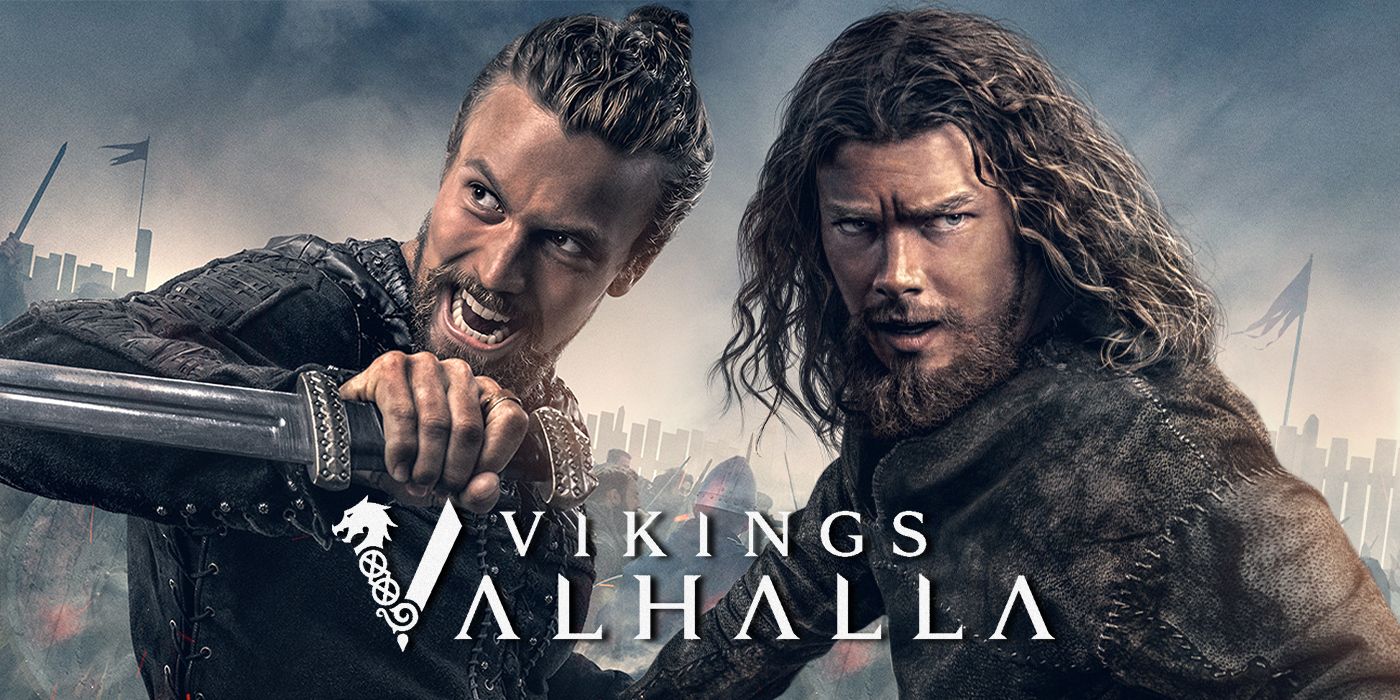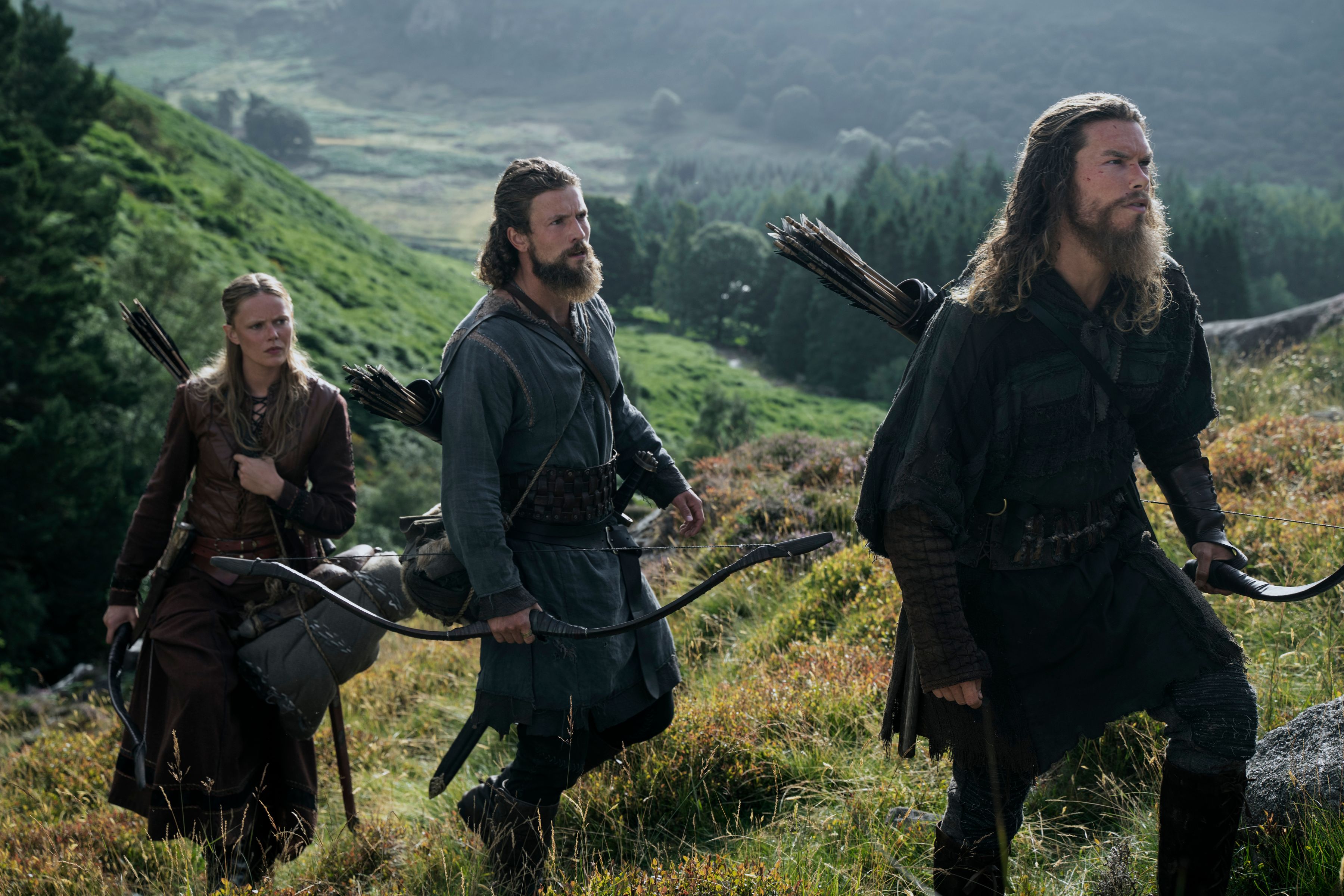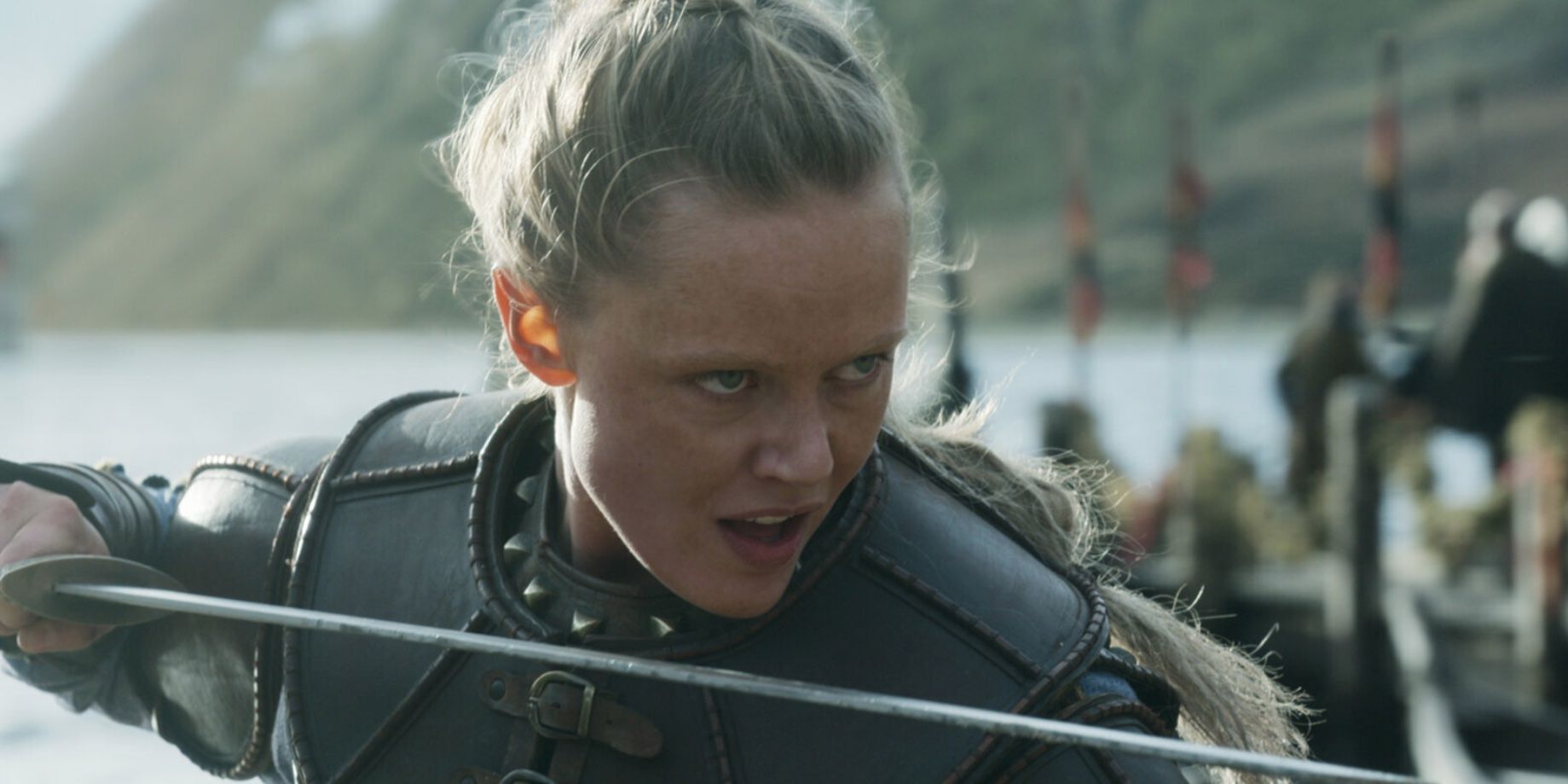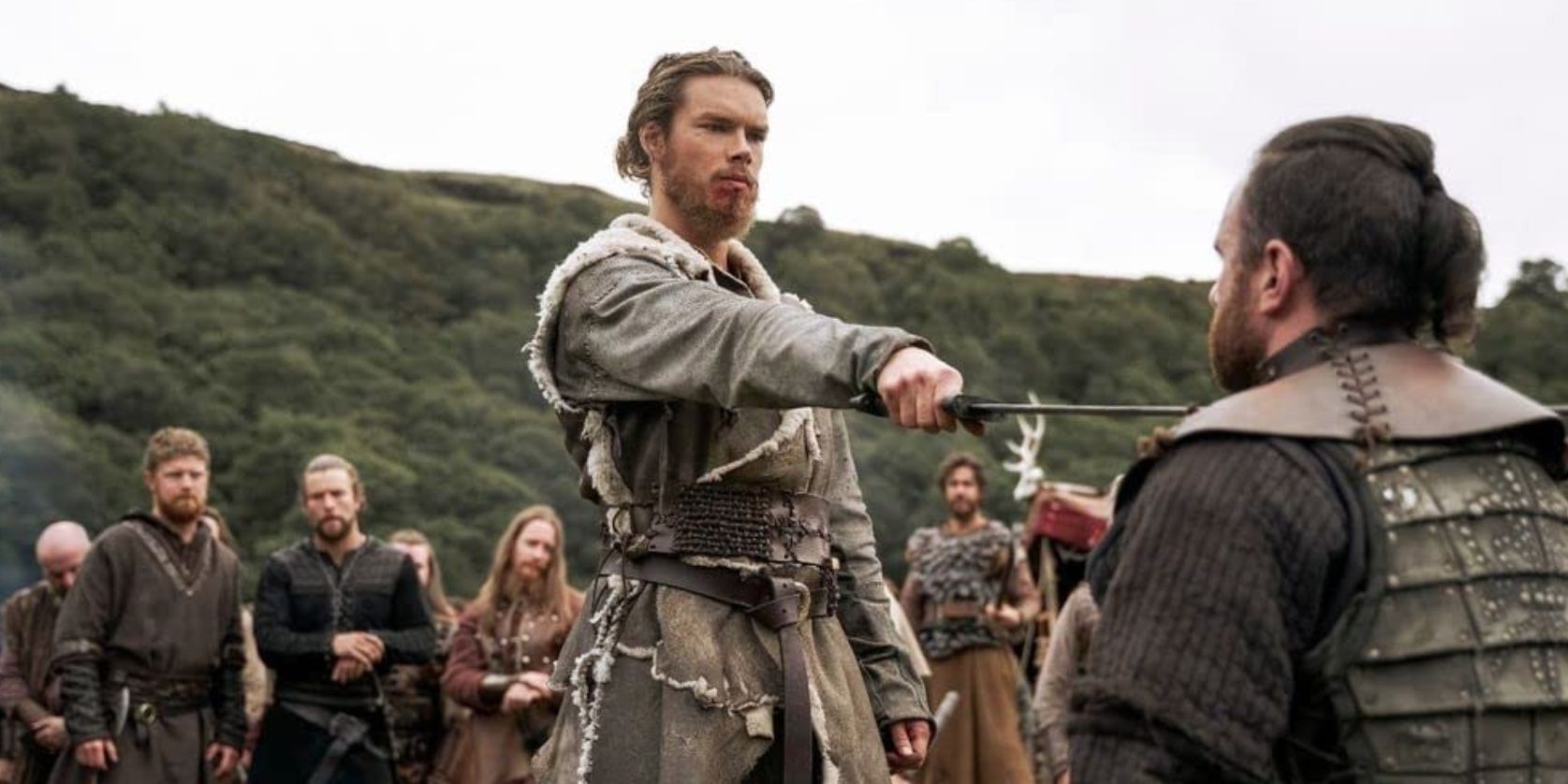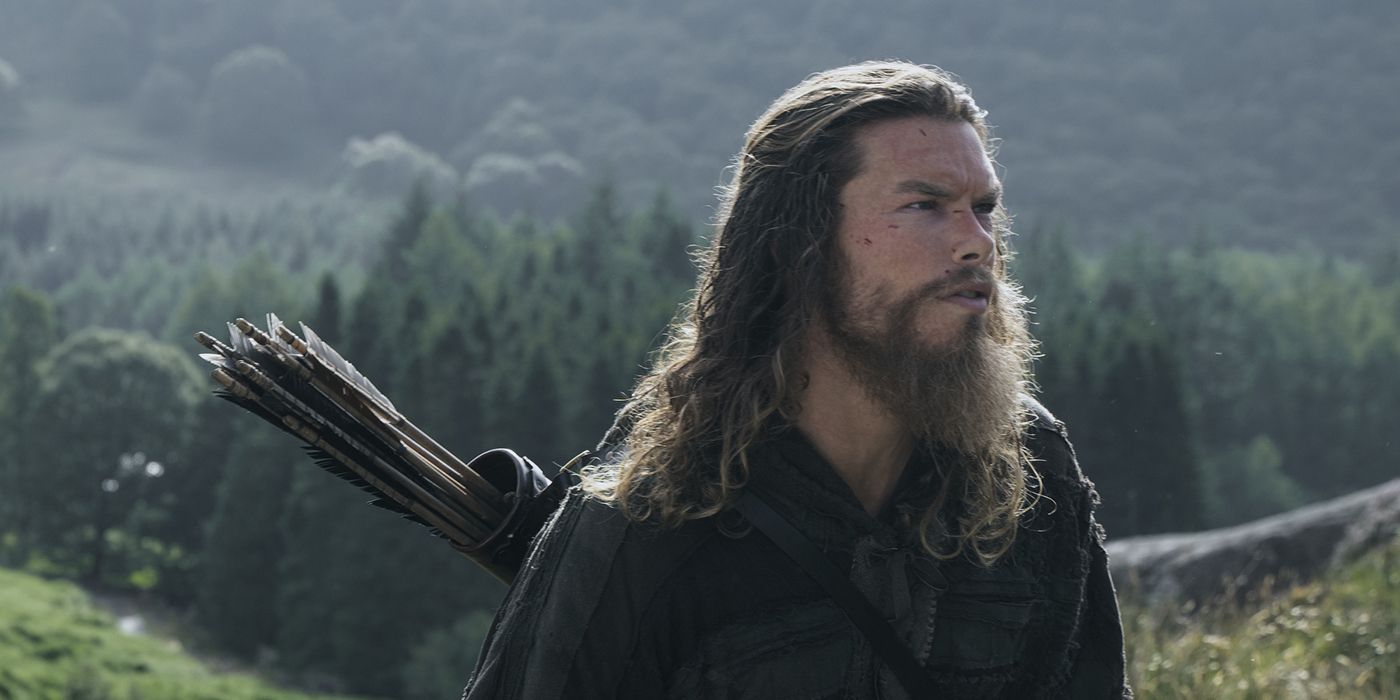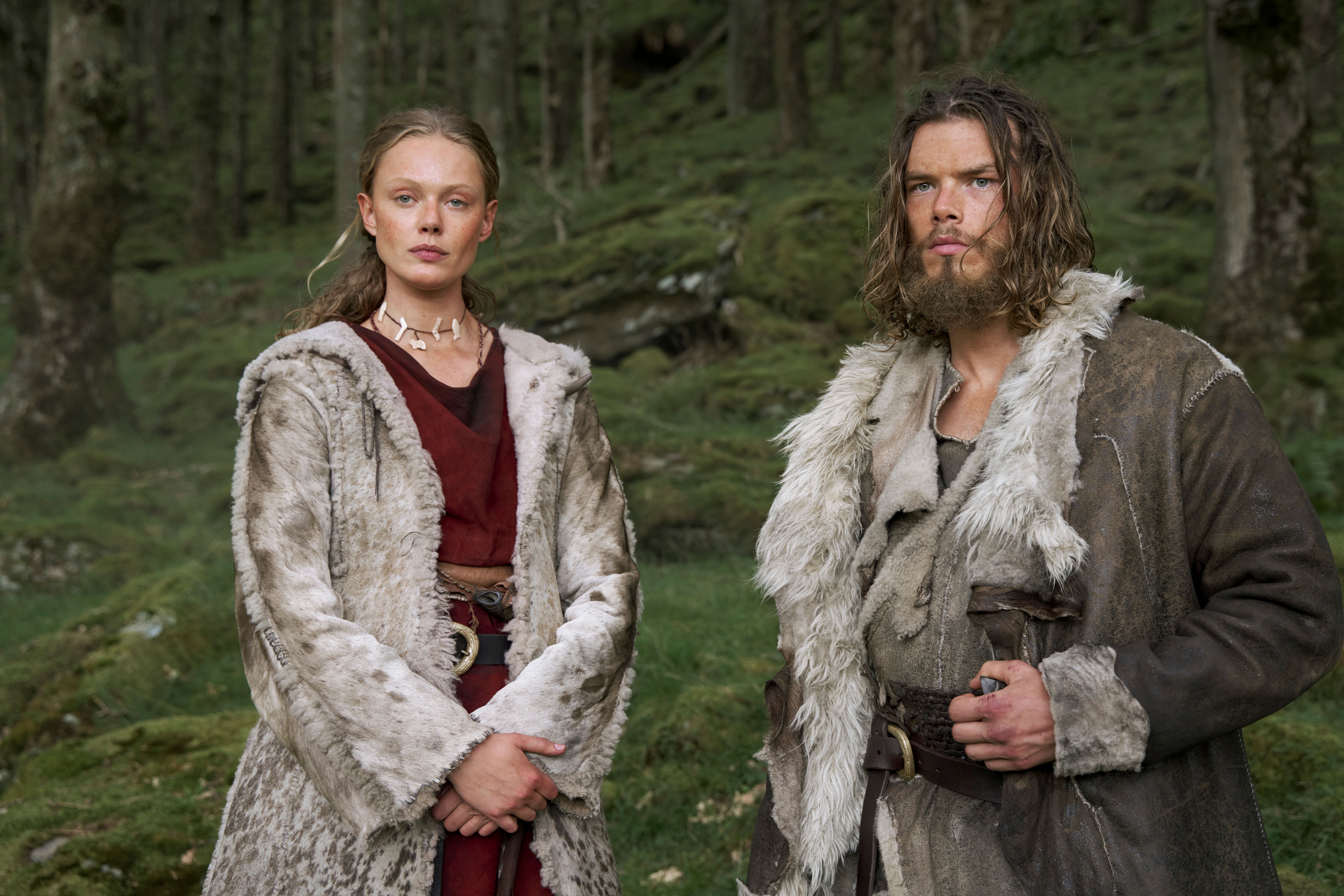If you missed out on Collider’s early screening for the Vikings: Valhalla Season 2 premiere, you’re in luck! You’ll still have to wait until January 12 to find out where our Viking heroes stand following the Battle for Kattegut, but read on for everything we learned from writer and creator Jeb Stuart and stars Sam Corlett, Frida Gustavsson, and Leo Suter during Collider’s Q&A with Editor-in-Chief Steve Weintraub.
After a wildly successful Season 1, Netflix ordered another two seasons of Vikings: Valhalla, which chronicles the journeys, triumphs, and hardships of the legendary Leif Eriksson (Corlett), his sister Freydís Eiríksdóttir (Gustavsson), and the Norwegian Prince Harald Sigurdsson (Suter). Season 2 will see the trio splitting paths, as Leif and Harald branch off on the Dnieper River, and Freydís undergoes a physical and spiritual journey in Pomerania.
Ahead of Vikings: Valhalla Season 2 hitting Netflix, we spoke with Stuart and the stars of the series about what fans can expect from Season 2, how hot it actually was while filming in the frozen Nordic winter, and Stuart’s plan for the series through another three seasons. Each of the main stars share which Season 2 shot was most difficult to film and discuss training and filming epic action sequences, working on-location, and so much more.
COLLIDER: So I'm going to start with the most important thing. How are you awake? Did someone just fly in from Paris?
LEO SUTER: I did just fly in from Paris. But I'm buoyed by this, very exciting to see people's reactions to our first episode so that's keeping me awake.
For people that don't realize, Jeb [Stuart] has written some movies, one of which is called Die Hard. And so a lot of people debate whether or not Die Hard is a Christmas movie, and why not ask the person who wrote it?
JEB STUART: It's definitely a Christmas movie. It's definitely a Christmas movie because I had to have the building empty. So it was either Thanksgiving or Christmas.
So I want to start with congrats on being a hit Netflix series. You guys filmed already Season 3, but I guess that's the sign that it’s a hit? Do they tell you, "Hey, it's doing well?" What do you hear?
SUTER: We're in the Netflix building. That's got to be a sign.
STUART: Yeah, they invited us all in. I think it's been a very interesting shoot. I've been in the business a long, long time, but we kind of felt it from the very beginning. It was a terrific chemistry with these guys, and I'm sure they'll back me up on this, we're really lucky to be working with the studio that's made Vikings and also a group of Irish filmmakers who are unbelievable, and just about anything we can throw at them, they can shoot. So we've had a good time.
So obviously people have not seen the rest of Season 2. What do you want to tease fans about the second season?
SAM CORLETT: I love what you wrote, in terms of the Thelma and Louise quote. Jeb said that Harald and Leif's journey through the Dnieper River is like Thelma and Louise, so accept that. I don't know who's who.
STUART: Well that's the teaser.
CORLETT: That's the teaser.
No, it is an epic journey. I'll let you speak for your side of things, but Harald and Leif's journey down the Dnieper River is just, we see so many new worlds at that time, and it's really beautiful. There's a lot going on in terms of Harald, he's got a clear physical, material journey, and Leif's is a bit more metaphysical and dealing with a lot of the grief and rage that has come up, and finding a way to deal with it.
FRIDA GUSTAVSSON: And for Freydis, it's a season of expansion in many ways. She enters these new worlds, both physically but also spiritually. She goes through something called motherhood, which as an actor, was so wonderful and so interesting to portray, so that's something we can look forward to seeing.
SUTER: I had to learn how to box, which is a teaser. Actually, shout out to Lee [McDermott], Scottish Mr. Miyagi, who told me that he's one of the stunt guys-
GUSTAVSSON: Legend.
SUTER: Big love, and thanks for your help. And then as well, Jeb had me in a harness. I can’t tease too much, but it's going to get weird. Harald is going to be put through his paces, and like you guys said, these characters are taken outside the Viking world and pushed to their limits, and they'll come through it by hook or by crook stronger on the other side.
I've seen half of Season 2, and I'm not going to reveal anything except to say that it involves winter and ice, and I think that those are two words that I can give away without a spoiler. When you read the scripts, and it says, "Outdoors, winter, ice," are you excited, or are you like, “Oh, F,?”
SUTER: It was like the hottest summer in Ireland.
CORLETT: There was a heatwave. We were fainting on set. We had an effortful scene with two other gentlemen, and literally I was speaking to one mid-scene, and he just blacked out because of how hot he was, even though it was like snow covered all around us.
SUTER: We were exerting ourselves and the four lads, four alpha males, all of whom forgot to breathe. And so after 30 seconds, suddenly I had a line I forgot to say. My brain went into fog. Taylor [James] fainted. But I don't think that was the heat, that was more just lads being macho, but it was hot.
GUSTAVSSON: I'm just laughing being Swedish, and I was so hoping, I was wanting to see some snow because I would actually be able to deal with it, but no, no snow for me.
While watching I did not realize you were shooting it in the heart of summer in a heatwave, so props. I am curious, how much have you actually figured out how far the show could go? What you're thinking about in terms of story? Have you thought, "Hey we get to Season 5, I have that figured out?" Or is it you're going season by season?
STUART: No, we're definitely not going season by season. I always knew that [in] Season 2, we were going to take these guys, and we were going to push them out.
We've tracked, in the storyline, because we can, a little bit of Leif Erikson's story, of Freydis' story, and also I was always fascinated how Harald Sigurdsson goes from Harald Sigurdsson to Harald Hardrada. From a historical standpoint, Harald got thrust out of Scandinavia and so these guys become fugitives from that point on, and that really set the standard because we then had to build the Viking legacy, as Leo says, outside of Scandinavia. You have to be a Viking somewhere else, and it is a challenge, and it's great for all their characters.
So I knew what Season 3 was going to be. I knew where Season 3 was going to be because of that change of culture, I knew that we have to eventually get to the New World. So what's in the toolbox? How do we fill up Leif's toolbox, and what does Freydis bring to get these people, who are the last hold out of the Pagan faith? And we know what's happening in Europe at that time. So it's exciting for us. And so yes, I'm not doing this season by season. I have a real plan, hopefully, for a four, five, and six.
SUTER: Yeah it's going to be cool.
As well, sometimes we'll have questions for Jeb, and he's been very open to having conversations with us, talking about our character. I say, "How does this work in this episode?" And then he'll go, "Well, in Season 3 this or that's going to happen." So we've had that since Season 1, actually, and it's been really useful for us as actors, having that huge bird's-eye-view of what this show is going to look like and where these characters are going to get to. It means, sometimes you don't have to rush to get there because there's time, lots of time.
One of the things that I find about the show is, there are times when you breathe, but there are other times when it's incredibly fast-moving, and it's because it's only eight episodes. And I'm curious, was it a Netflix decision to be eight episodes? Did you ever talk about six or ten?
STUART: It just seems like, we're in Netflix, everything is eight episodes, except when I was trying to pitch Liberator, and it had to be four episodes. But it works really well for us. There's a nice pattern that you can establish for this particular show. I can't speak for other people's shows, but for Valhalla it really works well for us on an eight-episode season. And as you said, there's a lot of pace to the show. We have a lot of characters, we get into the characters, but I think that, at its heart, it's an action show, and it's got a lot of movement to it.
Speaking of action, I'm curious for the three of you, you've done three seasons now of the show, which shot, specifically, was the one that you were like, “F this, this is a backbreaker,” from the episodes you've done?
GUSTAVSSON: Wow.
CORLETT: Chopping down the bridge. They had me doing that ax scene of the last pillar for about two hours, just hacking at it. So, that was pretty rough. And there were beams of wood before the beam of wood, and we went through about three of them.
GUSTAVSSON: I think for me, it’s a fight that you're going to see. I can't say who it is against, but I can say I still have scars on my hands, and we shot that 2021.
SUTER: Yeah, well like I said, there's a boxing moment, and we really got into it, and it was great fun, but the scariest shot was a close-up and Kay, who – I will fight against someone – his fist grazed my beard, and we were going all at it. So, if that had been a centimeter out, I might not have teeth at this point in time, but it's all about millimeters, but that was genuinely scary in a good way.
I'm very impressed with what you guys put on screen being a TV show, and some of those action set pieces look so well done. How much time do you actually have before you step on set to learn the dance moves, if you will, of a fight sequence? Can you talk about trying to bring it to life on a TV schedule?
SUTER: Yeah, I think it's one of the challenges because it's a TV schedule, and you're working all the time. But actually, this season the characters spread out in different routes. You've seen that we go in different ways, right? So, it kind of worked out that you would do your work for two weeks, and I'd have a two-week holiday, and then you'd-
GUSTAVSSON: Holiday.
SUTER: Yeah, and in that two weeks I'd be in the boxing room figuring it out. So, actually, there was a nice rhythm to this season with it, and then time off.
STUART: And then it starts probably two months before that, where we get together with Richard Ryan (stunt coordinator) and we plan the entire fight. We talk about how much it's going to be, “It's not going to be a three-minute fight, it's going to be a 30-second fight or a 90-second fight,” and he'll choreograph a 5-minute, as you guys know, and then I get to come in and figure out what part of that...
SUTER: But you do that late day, Jeb.
GUSTAVSSON: It's not the favorite when you rehearse the fight for two months, and you feel really good about it, you start doing it, and then Jeb comes in. He's like, "It's a bit long, isn’t it? Can we move that and that?" And you're like, man, all my good moves are gone.
STUART: I have to tell you, I have a fairly large office, and we've moved the furniture around many, many times in that office to go through the beats of a fight. Then they go off back to the sun shed and perfect it and come back. But it takes a lot of planning to pull it off on the TV schedule.
CORLETT: And also, perhaps, to the stunt team because they're always there and ready to go. If we are shooting another scene they'll say, "Hey, we're here if you want to rehearse the fight that's coming up." And so, that's always available. And often, we might be shooting a scene and as they're turning around and setting up the next shot, we'll go do a couple moves and then come back and shoot the scene.
You talk about a city that you guys are heading toward in Season 2. Do you want to tease that or not say anything?
SUTER: It's in the history books.
Well, I just don't want to be the one who says anything because going to a major city like that, from a long time ago, can be challenging to put it on screen and to build it all on a set. So what can you tease about that?
STUART: Well, I think for Season 2 it's the journey. It's the journey. The Vikings, historically, by the time we get to our series, the Vikings have already gone down the Dnieper River. In fact, even in the 20th century, they were still calling some of the rapids on the Dnieper by their Norse names. So, the Viking stuff is such an incredible stamp there. But that route that they took, [it] took them from the Baltic all the way down to the Black Sea and all the way to Constantinople. Did I tease that enough?
SUTER: But of course, Constantinople was the biggest city in the world. It was the Eastern Roman Empire. It was decadently wealthy and rich, and it had this pull, and that's in the history books. So yeah, that's a natural place for Harald who's on the run and has lost everything. That's a natural place where you're going to go if you want to make it big.
One of the reasons why I think the show feels so real to people is because you're not filming on sound stages all the time, you're on location. Can you talk a little bit about some of the places you actually film at, and what they bring to the show? Because it just makes it feel so authentic.
GUSTAVSSON: So Jomsborg is this legendary Viking city that still hasn't been found, so there's much debate about where it actually was in history. And I remember being shown sketches while we were filming Season 1, this incredible city with the harbor, and I was like, “Yeah, we're going to maybe not build all of that.”
Then we come back Season 2, and we built the city, the ground up, put water in there, built a harbor, we've got seven ships, all these buildings. It's just this scale that we operate on, it's just unbelievable, and it's so helpful for us to show up to work, and you're like it's an entire Viking city filled with people and animals and boats, and it's wonderful. It's absolutely magical.
CORLETT: And the Wicklow Mountains in Ireland have so much to offer. We just got to see so much of that county. And also, I want to mention Tom Conroy, who was our production designer. We'd have the grandeur of the mountains behind us, but then he'd come in with the nuances of the production design that just made it so real for us, as well.
SUTER: It's also, I think for fans of the original show, it's a nice homage, and a link to it because it's the same place where they filmed, so we go to different locations but for the eagle-eye amongst the fans, they might be able to see similarities, and I think that's a nice touch because it threads that link through these two separate shows, but in a nice way.
Ultimately the editing is where everything comes together. So how has the show changed, at all, in the editing room in ways, perhaps, you weren't expecting?
STUART: We were very fortunate to be able to work with the same production groups, and the same post-production groups, that we worked with [on] Vikings. The biggest change is pace. I'm a huge fan of the Michael Hirst original, but it had a different pace than Valhalla does, and Valhalla is designed and built to do that. And so, I can't tell you how many times I would come into a meeting and put the script down and say, "Okay, we're going to take down London Bridge," and it's like, “We're going to what? We can't do that. We absolutely can't do that.” Next thing you know, we build five bridges, and we pull it down.
And the same thing happens in post-production, too. It's the old Jay Leno thing about, “Somebody go crash a car, do something.” So, getting that into the editors, into the pacing, into the music, into every aspect of post-production and the editing room. We're way up to speed, but it was part of the re-education part.
Yeah, I'm very impressed with the scope and scale of what you accomplish. For people that have seen the first season, you know what the show has done. I'm curious, when you guys are on set, because you are on a television schedule, you got to make your pages, do you actually get a lot of takes, or do you feel like there are certain locations with light, that you need to nail it on that first take?
CORLETT: It's pretty under the pump all the time, but there's something to what that pressure does to us in terms of, we need to be quiet, work as a team with the crew and the cameramen. And it's certainly, for an actor, the best education you can possibly get because, in terms of filmmaking, you are thinking from a director's eye, as well, and how best to communicate the story as quickly as possible. Where a film might have four days for it, we have four hours for it. And so, it's difficult, but the crew is already a very well-oiled machine from 10 years of Vikings, and then we get to come in and play around, and if we are in the pump, we'll call each other over Zoom or FaceTime, and we'll rehearse at night, or we'll try to do something when we're not shooting.
STUART: These guys set the tone for everybody. We have a huge cast, and especially during COVID and stuff, it was these three who said, “This is how it's going to work,” and everybody fell in behind them.
I also think we're shooting in Ireland, and it's like Sam said, as you get past June 21 the days start getting shorter rapidly, and some of those great scenes that are in Season 1 are being shot in late October, and it looks like Freydis is walking through Uppsala, and it's like 7 o'clock at night, it's 3:30 in the afternoon. You just have to go. But we've got folks who are used to shooting in that type of light and that type of environment. It also gives part of that great northern feel to it. There are times when, as Sam was saying, up in Wicklow Mountains that you really do feel like you're in Norway in places, and the light helps a lot.
I also think that people don't realize, with digital cameras you can now shoot a lot more in lower-light situations.
STUART: Yeah.
Have you ever felt like you were on set, and it's dark, but the camera's still going, and you're like, “How are you filming this?”
STUART: It is dark.
CORLETT: Absolutely. Yeah, absolutely. And also, Peter Robinson, our DP, he's constantly doing this. Because not only is the light, because of the time of day, changing, but where we were shooting was like microclimates, and so at one point it's raining and the next it's sunny and you have to adapt and adjust as you're going. And yeah, he's definitely turning those things to make the light look good.
Vikings: Valhalla Season 2 begins streaming only on Netflix, January 12. For more with the cast, here's our video interview with Leo Suter, Frida Gustavsson & Sam Corlett.

